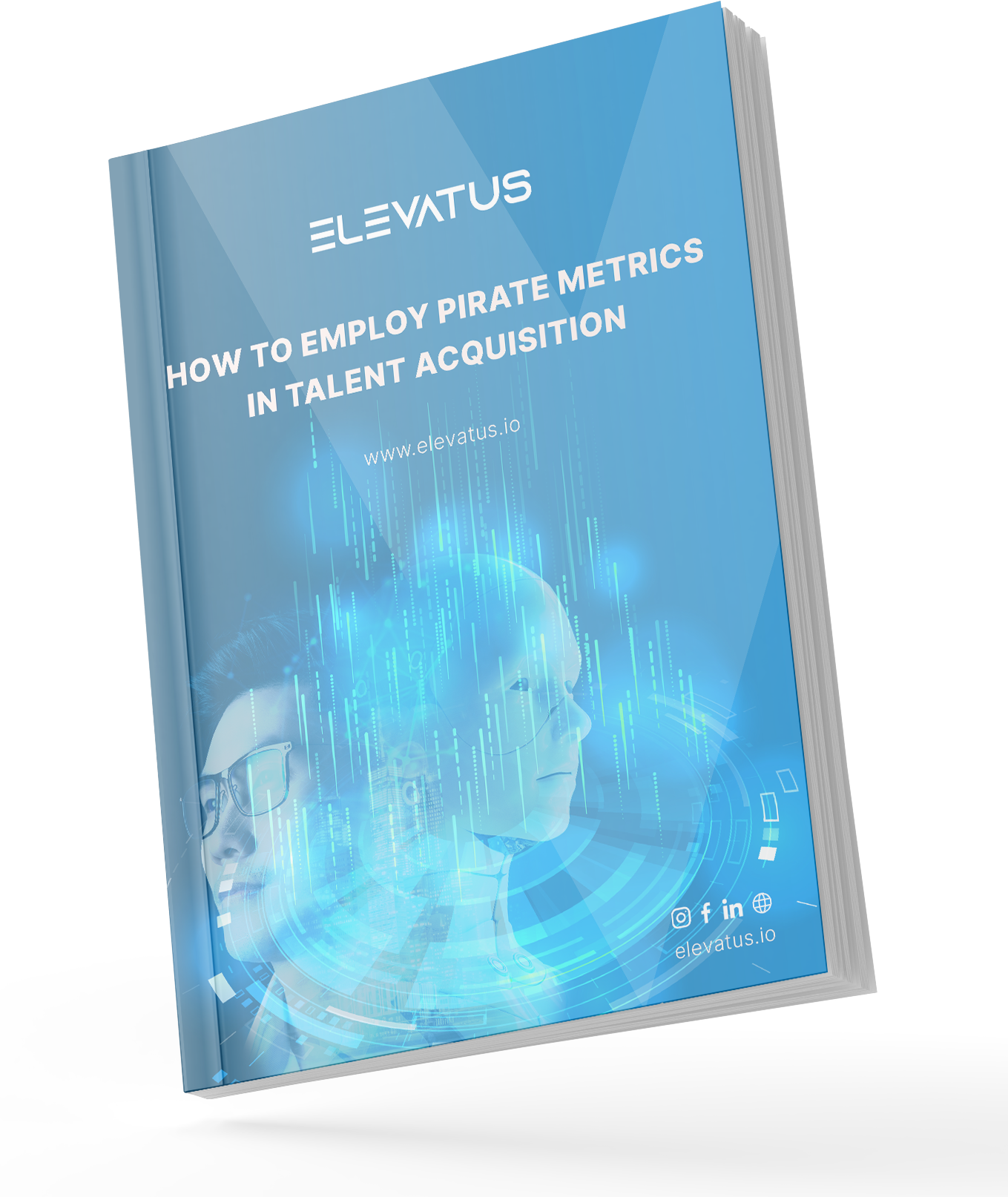
General
Discover Recruitment Analytics with EVA-REC: Your Key to Smarter Hiring!
April 18, 2024
Reem Al-Tamimi
Content Writer
“Data is power” – a phrase that becomes more relevant in today’s competitive hiring landscape. If you’re still relying solely on intuition for recruitment—you’re missing out on the transformative capabilities of recruitment analytics provided by advanced applicant tracking systems like EVA-REC, which offers advanced recruiting analytics that not only pinpoint bottlenecks but also help you keep an eye on all your recruitment KPIs.
This software isn’t just about tracking candidates; it’s a gold mine of analytics and reports. It dishes out vital stats like how long it takes to hire, the cost of each hire, and which channels bring in the best candidates. Having this kind of detailed information at their fingertips allows companies to dive deep into their hiring processes. They can celebrate what’s working and, more importantly, identify and improve the parts that aren’t up to snuff.
With this wealth of data, companies can sharpen their recruitment strategies, making them more precise and impactful. It’s about using resources smarter, not harder. This approach doesn’t just bump up the efficiency of hiring; it also enhances the quality of each hire. Decisions backed by clear, actionable data are likely to hit the mark more often than those based on hunches. In a nutshell, talent acquisition software turns recruitment into a finely tuned, information-driven process, greatly upping the odds of finding the right fit for every role.
Grab your cup of tea and explore how advanced recruiting analytics can transform your hiring approach with EVA-REC. Harness insights that help you choose the right candidates, uncover effective methods to attract top talent, reduce recruitment costs, and align newcomers with your company’s strategic objectives. Leverage data for smarter, results-driven hiring decisions that turn recruitment into a strategic asset.
Get advanced analytics and recruiting reports
Collaborate with your colleagues and enhance your hiring process by leveraging real-time recruiting analytics, reports, and insights – that track progress and easily identify areas for improvement.
Request a demoTable of Contents
How Recruitment Analytics Can Skyrocket Your Hiring


Recruitment analytics is transforming how HR teams operate, turning raw data into essential insights that sharpen your hiring process. If you’ve noticed a spike in early turnover, this could be a sign that something’s off—maybe your job descriptions don’t match the reality of the roles, or perhaps your onboarding needs a reboot. These insights help you fine-tune your approach, ensuring that you not only fill positions but do it right.
Ever wonder which of your recruiting channels is performing best or what traits your star hires have in common? Recruitment analytics doesn’t just track numbers; it decodes them to show you patterns and opportunities. With this knowledge, you can strategically adjust your efforts, whether that means reallocating resources to more effective channels or tweaking your interview process.
And there’s more to it than immediate fixes. Some tools keep a detailed record of your hiring activity, providing a clear view of each candidate’s journey through your hiring process. This ongoing record isn’t just bureaucratic – it’s a goldmine of insights, helping you build a stronger workforce and refine your strategies continually. Every hire, every interview, and every resume becomes a building block for a smarter approach.
Recruitment Analytics: Unveiling the Levels to Master Your Hiring Process


In today’s fast-paced business environment, mastering your hiring process through recruitment analytics is not just a luxury—it’s a necessity. By delving into the depths of data, businesses can refine their recruitment strategies, optimize processes, and forecast future needs. Let’s break down the complexities of recruiting analytics into three distinct levels: operational reporting, advanced reporting, and strategic predictive analytics.
Level 1: Operational (Descriptive) Reporting
At the foundational level, operational reporting focuses on the core metrics of your hiring process. These include your cost of hiring, applicants per open position, time to fill, and time to hire. By monitoring these metrics, HR teams can pinpoint inefficiencies and areas needing immediate attention.
Operational reporting serves as a real-time health check for your recruitment activities. Are your hiring teams meeting their targets? Are processes streamlined and efficient? For example, if the time to fill a position is lagging, it might be time to reassess your sourcing strategies or provide additional training to your recruitment staff. Utilizing an Applicant Tracking System (ATS) like Factorial HR can significantly streamline these tasks by automating data collection and report generation. Such systems not only manage every stage of the hiring process but also integrate seamlessly with HRIS systems, ensuring a smooth transition from candidate to employee.
Boost your applicant tracking process
Move faster on a platform that automates admin tasks; from posting jobs to sending electronic offer letters. Elevatus helps you use AI and automation to become great at hiring.
Automate your hiringLevel 2: Advanced Reporting
Moving beyond the basics, advanced reporting dives deeper into the qualitative aspects of your recruitment strategy. This level involves analyzing recruitment sources, assessing the cost per candidate, and evaluating the effectiveness of your employer branding and recruitment funnel conversions.
Advanced reporting helps you understand the “why” behind the numbers. For instance, by analyzing candidate surveys and journey mapping, you can gain insights into the candidate experience. What are their perceptions of your hiring process? Where do they feel most engaged or disconnected? This level of analysis requires gathering data from various sources, including direct feedback from candidates and performance metrics from your recruitment campaigns. Tools that measure your employer brand’s impact also play a crucial role here, helping you align your recruitment efforts with your organization’s image and attract the right talent.
Level 3: Strategic and Predictive Analytics
The pinnacle of recruitment analytics is strategic and predictive analytics in recruitment. This advanced stage uses statistical analysis and segmentation to create detailed candidate personas and predict future hiring needs. By understanding different candidate segments and modeling their journey through your recruitment funnel, you can anticipate challenges and barriers that may prevent them from completing the application process.
Predictive analytics allows you to go beyond reacting to current trends and start anticipating future dynamics. For instance, if you notice that certain roles have higher turnover rates, predictive models can help you identify the root causes and predict which candidates are likely to stay long-term. This proactive approach not only optimizes hiring costs but also improves candidate conversions by ensuring a smoother, more engaging candidate experience.
Furthermore, HR analytics in recruitment provides a framework for continuous improvement. By consistently analyzing the data from all three levels of analytics, organizations can refine their recruitment strategies, adjust their practices in real-time, and better align their HR objectives with broader business goals.
Overall, mastering the three levels of recruitment analytics – operational reporting, advanced reporting, and strategic predictive analytics – enables businesses to transform their recruitment process into a data-driven powerhouse. Each level builds upon the previous one, offering more profound insights and greater predictive power. By effectively leveraging these analytics, companies can not only fill positions with the right candidates but also enhance their overall competitiveness and success in the marketplace.
How to Employ Pirate Metrics in Talent Acquisition
Navigate the seas of data-driven recruitment! Dive deep into the transformative power of pirate metrics in reshaping talent acquisition. Leverage the AARRR framework for insightful, results-oriented hiring strategies.
Read Now!

The Role of EVA-REC in Powering Recruitment Success with Analytics


In the realm of HR, leveraging data through recruitment analytics is no longer just an option but a necessity for staying competitive and making informed hiring decisions. With EVA-REC, a leading Applicant Tracking System (ATS), organizations can tap into the power of data to transform their recruitment processes. Let’s explore how EVA-REC serves as a pivotal tool in harnessing recruitment analytics tools, enabling businesses to optimize their recruitment strategies.
Overview of EVA-REC and Its Capabilities
EVA-REC is not just an ATS; it’s a comprehensive platform that enhances recruitment operations with its precision and accuracy in analytics. This system provides a user-friendly recruitment analytics dashboard that gives HR professionals a complete overview of the recruitment landscape at a glance. From tracking key trends and identifying bottlenecks to monitoring success metrics, EVA-REC offers a detailed snapshot of the entire recruitment process. Its customizable features allow users to tailor the dashboard to meet specific needs, ensuring that every crucial piece of data is just a click away.
How EVA-REC Integrates Predictive Analytics for Recruitment
Moving beyond traditional analytics, EVA-REC incorporates predictive analytics for recruitment. This advanced feature enables HR teams to forecast future hiring needs based on historical data and market trends. By analyzing patterns such as employee turnover rates, skill gaps, and hiring cycles, EVA-REC helps predict what future recruitment needs might look like, allowing companies to proactively plan and strategize their talent acquisition efforts. This predictive capability ensures that businesses are always one step ahead, ready to attract and retain the right talent at the right time. Experience our predictive analytics features firsthand—click here to explore one of the most comprehensive recruitment software solutions available.
Features of EVA-REC That Support Comprehensive Recruitment Analytics
EVA-REC is equipped with various features that support comprehensive analytics for recruitment. Its flexibility and visual interface make it particularly valuable for HR professionals. Users can customize the data presented on their dashboards by selecting specific insights they wish to track, such as job opening metrics, candidate sources, and recruitment timelines. Additionally, the ability to extract data into CSV files allows for deeper analysis and sharing across departments, facilitating data-driven decision-making throughout the organization.
Utilizing EVA-REC for Advanced Recruitment Analytics Metrics and Analytics in Recruitment
For organizations aiming to delve deeper into recruitment analytics metrics, EVA-REC provides advanced tools to measure key performance indicators such as time-to-fill, cost-per-hire, and source effectiveness. These metrics are essential for understanding not only the efficiency of the recruitment process but also its effectiveness. For instance, if certain recruitment channels are underperforming, EVA-REC’s detailed analytics can pinpoint these inefficiencies, allowing recruiters to adjust their strategies to better meet their goals.
Take the example of Nucorp, a leading shared services provider. They leveraged Elevatus’ AI recruitment software, similar in functionality to EVA-REC, to develop a sophisticated system for assessing each recruiter’s management of job openings and the quality of candidates they sourced. This enabled them to optimize their recruitment strategy based on detailed, personalized analytics. By evaluating the performance and outcomes associated with each recruiter, Nucorp could make informed decisions to enhance the efficiency and effectiveness of their hiring process, thereby sourcing top-tier talent more consistently.
Hire with brainpower, not manpower
From job posting to onboarding – see how our next-gen ATS can help you streamline your recruitment process through AI and automation.
Request a demoKey Recruitment Analytics Metrics to Monitor
When it comes to optimizing the recruitment process, understanding and monitoring key metrics is essential. EVA-REC excels in providing comprehensive insights into several critical recruitment analytics metrics, each serving as a cornerstone for refining strategies and enhancing the overall candidate experience. Here’s a deeper look into these pivotal metrics:
- Time to Hire: This metric measures the duration from when a candidate is first contacted to when they accept the job offer. It is crucial to assess the efficiency of the recruitment process. A shorter time to hire can indicate a more effective recruitment strategy, but it’s essential to balance speed with the quality of hires.
- Time to Fill: Unlike time to hire, this metric tracks the time from when a job is posted until it is filled. It helps HR teams understand the overall responsiveness and efficiency of the hiring process.
- Source of Hire: This metric identifies which recruitment channels (e.g., job boards, social media, referral programs) yield the highest return on investment. Understanding which sources produce the best candidates allows organizations to allocate resources more effectively and boost recruitment efforts.
- Cost per Hire: This includes all expenses associated with the hiring process, from advertising job openings and recruiting staff to the technology used, like EVA-REC. Monitoring this cost helps organizations optimize their budget allocation and reduce unnecessary spending.
- Candidate Experience: How candidates perceive their interaction with your company during the hiring process can significantly impact your brand’s reputation and your ability to attract top talent. Positive experiences can lead to higher offer acceptance rates and encourage more candidates to apply in the future.
- Offer Acceptance Rate: This metric compares the number of accepted job offers to the total offers made. A low acceptance rate might indicate issues with the offer terms, the company’s reputation, or the candidate experience.
- Age of Job: Measures how long a position remains open. Prolonged job vacancies can be costly and may signal inefficiencies in the recruitment process or unattractive job propositions.
- First-year Attrition: Tracks the percentage of new hires who leave the company within their first year. High attrition rates can indicate mismatches between the job roles and the hires or deficiencies in the onboarding process.
- Quality of Hire: This metric assesses the performance and productivity of new hires during their first year. It is often gauged through performance reviews and output levels, reflecting the effectiveness of the recruitment process.
- Selection Ratio: This ratio shows the number of hired candidates compared to the total number of applicants. It provides insight into the competitiveness of the hiring process and the selectivity of an organization.
- Selection Channel Effectiveness: Evaluates the success of different recruiting channels based on the ratio of applications received to the number of job impressions made. This helps pinpoint the most effective channels for attracting candidates.
But that is not all. EVA-REC allows you to customize any recruitment metric you want to track, giving your team the flexibility to focus on what matters most to your organization’s specific needs. By leveraging EVA-REC’s capabilities to monitor and analyze these metrics, organizations can gain invaluable insights that help streamline operations, improve recruitment outcomes, and enhance the overall strategic approach to hiring. This data-driven approach ensures that recruitment efforts are not only effective but also aligned with the broader goals of the organization, making EVA-REC an indispensable tool in the arsenal of modern HR professionals.
Interpreting Data for Strategic Recruitment Decisions
The strength of EVA-REC lies in its capability to convert vast amounts of data into actionable insights. By interpreting data collected through the platform, recruiters can make strategic decisions that align with the broader organizational goals. This might involve reallocating resources to more effective recruitment channels, enhancing employer branding, or revising recruitment policies to attract top talent. Strategic data utilization ensures that recruitment efforts are proactive, shaping a robust workforce that drives business success.
This integration of a practical example like Nucorp underscores the transformative impact of analytics in recruitment and how EVA-REC can be instrumental in achieving significant improvements in recruitment strategies.
Overcoming Challenges in Recruitment Analytics


Recruitment analytics is the recruiter’s high-powered lens that brings clarity, precision, and efficiency to the hiring process. Yet, the integration of these powerful tools into day-to-day recruitment strategies often encounters numerous hurdles. Let’s explore the common obstacles faced when adopting recruitment analytics and how sophisticated tools like EVA-REC can help overcome these challenges effectively.
Common Obstacles in Adopting Recruitment Analytics
The road to fully leveraging recruitment analytics can be rocky. A significant challenge is managing the vast amounts of data involved. Organizations often find themselves grappling with how best to collect, interpret, and use this data effectively. Additionally, cultural resistance is common as traditional hiring practices are deeply ingrained in many companies, and shifting to a data-driven approach can be met with skepticism.
Moreover, a skills gap can hinder the process. Not all HR professionals come equipped with advanced data analysis skills, making the implementation of sophisticated analytics solutions challenging. Privacy and security concerns also loom large, especially in tightly regulated industries where data handling must comply with strict standards.
Strategies for Overcoming These Challenges with a Focus on EVA-REC
EVA-REC is designed to simplify the adoption of recruitment analytics. Its user-friendly recruitment analytics dashboard allows HR teams to effortlessly visualize data, track key metrics, and gain actionable insights without needing a deep technical background in data analysis. This simplifies the interpretation and application of data, making it accessible to all members of the recruitment team.
The platform itself helps mitigate the skills gap by providing a system that’s easy to navigate and understand. While EVA-REC might not offer comprehensive training and support, its intuitive design and straightforward reporting tools mean that even users with minimal analytics training can harness its capabilities effectively.
On the front of data security, EVA-REC employs robust protection measures to ensure that all recruitment data is secure and handled in compliance with relevant data privacy laws. This builds confidence within the organization and assures teams that their data practices are both ethical and compliant.
EVA-REC enhances the quality of hires by offering insights that allow recruiters to identify the best attributes of each candidate, ensuring that new hires are not only skilled but also a good cultural fit. This capability is crucial for improving the quality of hire, a vital metric in recruitment analytics.
Furthermore, EVA-REC’s data-driven insights enable precise decision-making. By relying on factual data rather than intuition, hiring decisions become more accurate and aligned with the organization’s strategic needs, boosting recruitment efficiency.
Additionally, the platform supports a positive candidate experience by tracking feedback and behavior, enabling HR teams to refine their recruitment processes and improve communication and engagement throughout the hiring cycle. This not only elevates the employer’s brand but also aids in achieving higher retention rates.
Lastly, EVA-REC aids in crafting targeted recruitment strategies. By providing detailed analytics, the tool helps eliminate guesswork and increase the strategic placement of talent, effectively reaching and engaging the desired candidates.
In summary, while the integration of recruitment analytics like those offered by EVA-REC can present several challenges, the strategic use of this tool can significantly streamline and enhance the recruitment process. EVA-REC transforms recruitment into a data-driven operation, empowering organizations to attract and retain top-tier talent efficiently and effectively.
The Future of Work and Its Impact on Recruitment
Next Steps …
Harnessing recruitment analytics is more than just a strategic move; it’s a transformative one that directly impacts business outcomes. By delving into analytics, companies gain the power to make smarter hiring decisions, which, in turn, enhances workforce quality, reduces turnover, and optimizes recruitment costs. Imagine aligning every hire with your business goals, predicting future needs, and continuously improving your recruitment processes. That’s the real-world impact of integrating robust analytics.
As you move forward, consider how deep insights can refine your recruitment strategies and propel your entire business forward. Are you ready to take that step?
EVA-REC is an award-winning applicant tracking system that helps companies from all across the globe source, attract, and hire top talent at scale. Where in one centralized place, HR teams can collaborate with company staff and use advanced analytics to evaluate candidates fairly and equitably. Through AI, cutting-edge technology, and 2,000+ world-class integrations – EVA-REC helps companies slash their hiring costs by up to 96%, reduce time-to-hire by 80%, improve the quality of hire by 85%, ramp up the candidate experience, and save more than 17 hours per hire. Request a free demo today!
Turn top talent to employees fast
Hire, assess, onboard and manage top talent for every job. See how Elevatus streamlines everything; from acquire to new hire.
Request a demoAuthor
Reem Al-Tamimi
Don't miss a thing!
Stay one step ahead. Subscribe and get the latest updates, news, and insights from Elevatus straight to your inbox.






